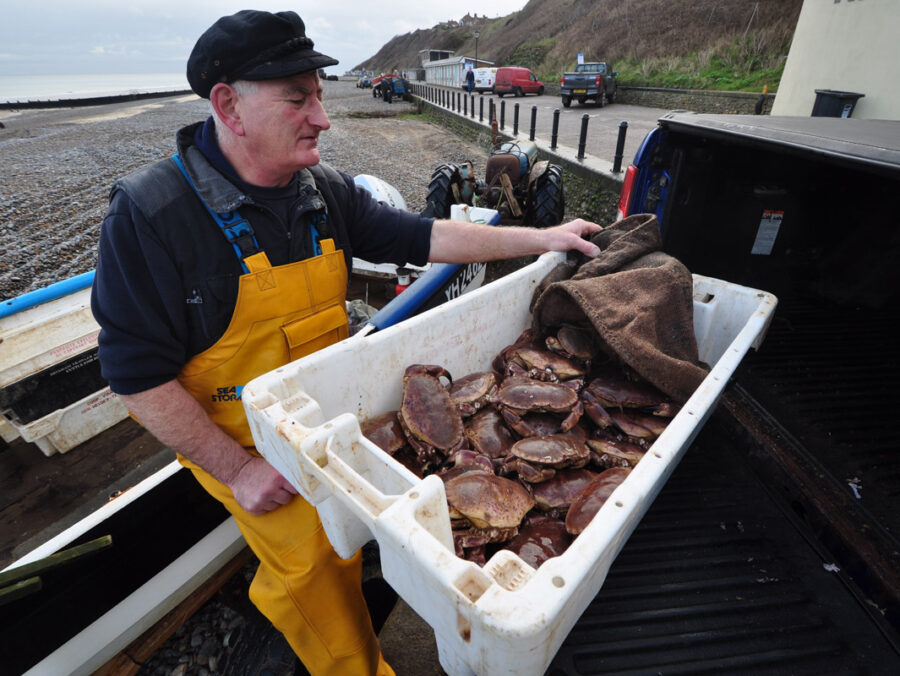Back in 2016, among the second tranche of Marine Conservation Zone (MCZ) designations was the Cromer Shoal Chalk Beds MCZ, which has as its main feature a chalk reef, reputedly Europe’s longest, just off the North Norfolk coast. It is the reef on which the iconic Cromer crab is caught.
Potting for crabs and lobsters has gone on there for 300 years or more – in the 1720s, Daniel Defoe mentioned lobsters going from Cromer to Norwich and sometimes by sea to London – but the fame of the particularly sweet Cromer crab went viral after the railway reached Cromer in 1877.
At the time of the designation, Natural England (NE), the government’s adviser on the natural environment, considered potting on the reef to be ‘selective, small-scale and low-impact’, and not a problem – but there was nevertheless trepidation among fishermen.

What it’s all about – dressed crabs for the visitor market.
“I don’t know what it’s going to do, to be honest,” said John Davies at the time. He’s an eighth-generation crab fisherman, chair of the North Norfolk Fishermen’s Society and, back then and still, a member of Eastern IFCA. “At the moment, they say what we’re doing is fine, and to carry on. But the problem is that they get these places designated and then they move the goalposts.”
And now it seems that the goalposts have indeed been moved. ‘Compelling evidence’ submitted in December 2018 has seen NE change its tune, and in August 2020, it issued formal advice to EIFCA to the effect that potting is doing damage after all, in particular to the rugged chalk formations that occur closer inshore – where most boats work.
The advice says that although individual impacts are small, their effects are cumulative and could hinder the MCZ’s conservation objectives, and so fishing methods will have to be adapted. And if the adaptions were then to be deemed inadequate, a precautionary approach would be needed, which would see potting banned on ‘complex outcropping chalk’. And there would go the prime ground for the iconic Cromer crab.
So let’s consider the reef, the fishery and the rules as they stand.
The MCZ stretches for just over 30km, from Weybourne in the west, past Cromer, to Happisburgh in the east and up to 10km out to sea, with chalk, rugged and otherwise, featuring in roughly two-thirds of its 321km2. The ‘rugosity’ is more pronounced closer to the shore, with some features two to three metres high towards the western end, off Sheringham. Flatter areas of chalk, along with flint cobble and mixed sediments, make up much of the rest.
At the turn of the 20th century and still in the days of sail, there were four or five dozen boats working from Cromer beach, and even more at Sheringham, and they were all making a living, albeit hauling manually and working fewer pots per boat than today. Even in the late 1950s, well into the engine era, Cromer had a couple of dozen, and Sheringham 15. These days, there are barely 30 in total, a majority single-handed, working between Weybourne and Happisburgh, 14 of them from Cromer and just five now from Sheringham, with the rest divided between the villages up and down.
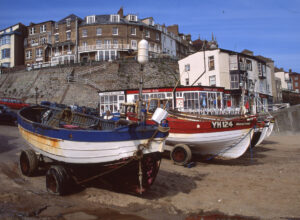
The way things were – wooden double-enders, worked two- or three-handed, seen here at Cromer in 1991.
And yet that small fleet, together with the processing and supply lines ashore, remains at the core of North Norfolk’s culture and tourism, providing the product with which Cromer is synonymous.
The crabs’ sweetness hinges on conditions on the reef. Studies in the 1960s found that crabs grow more slowly there, and are smaller on reaching maturity than elsewhere, and the size difference is quite marked. English Channel males occasionally reach a 250mm carapace width, whereas in the southern North Sea, 180mm is big, with large specimens more common in deeper water offshore.
That characteristic was recognised in 1986 when the crab minimum landing size (MLS) was revised nationally. It had been 115mm since 1951 (and before that, 108mm since 1877), but what is now the EIFCA area was given a derogation to retain 115mm, while the MLS elsewhere was increased to between 130mm and 160mm.
Tagging studies have also shown that larger impregnated females migrate away from the chalk to deeper water, with a tendency to move northwards against the residual current, some as far as Yorkshire, before they settle into mud or sand and become inactive for several winter months while they incubate their eggs. After hatching, the larvae spend five to six weeks in the water column, and the thinking is that a tiny fraction of survivors, along with larvae from the wider North Sea, are brought to the reef by longshore drift in a circulatory system that replenishes the reef’s crab stock to grow to the smaller MLS full of the denser, sweeter meat of Cromer fame.
In 2016, an EIFCA report said: “Mortality estimates for C. pagurus specify high levels of exploitation for this species and indicate that growth overfishing is occurring. Despite this, there does not appear to be any significant impact on recruitment.” That replenishment from elsewhere is thought to have something to do with it.
The 115mm MLS furthermore suits North Norfolk because, although the big processors prefer bigger crabs, smaller crabs are popular with visitors, who like them bite-sized – enough for one helping. And for boats that fish the reef, that visitor market is crucial.
But now comes this potentially existential threat to the fishery.
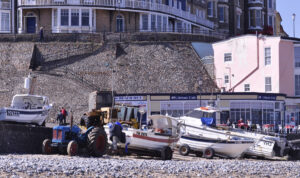
The way things are now – fibreglass skiffs worked single-handed.
The ‘compelling evidence’ that triggered the recent formal advice came from the diving fraternity and specifically Rob Spray, who has dived in various parts of the world, as well as on the Cromer chalk reef. He also happens to be a longstanding member of EIFCA, and has been campaigning for protection of the reef for some time.
“My interest is in the health of the reef, not the health of the fishery,” he told Fishing News. “If a healthy fishery stems from the health of the reef, I’m not troubled by that. I would hope that the health of the reef is put first, that we properly understand how to maintain the health and diversity of the reef, and that fishing addresses its impacts and goes completely transparent.”
In August 2018, in an interview on BBC Look East, he was espousing no-take zones, and still does.
“Any fishery that wants to prove its admirable qualities should be willing to protect and establish a no-take area, whereby it could demonstrate that its practices weren’t causing unnecessary damage to the areas it was allowed to fish.”
How big an area? “We talked about a half kilometre square, although it’s complicated because of the tidal patterns round North Norfolk. But it would need to be large, and protected from accidental impacts such as gear drifting in.”
The paper that he put to NE in late 2018 included 17 photographs, some showing white chalk which he said was evidence of damage from pot impact or rope abrasion; five of the images featured pots and/or ropes. Thus compelled, NE decided to have a closer look.
In September 2019, an NE dive team made four dives off Sheringham and East and West Runton on rugged sections of the reef. They swam along four randomly selected shanks of pots and noted damage to the chalk caused, they concluded, by pots, ropes or anchors.
Their report said: “Although each incidence of damage observed was small-scale, the additive effect of these small-scale impacts over time could be altering the structure on a larger scale (and therefore biological function of the chalk) in a more rapid and focused way than natural change would be.”
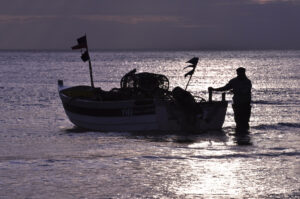
In spring, as soon as the weather allows, potz are taken out to start fishing.
The team say they encountered 11 types of damage, although their report illustrates these with diagrams rather than photographs. But it does also refer to later testimony from Rob Spray: “Photographic footage of damage to the chalk reef from other sources suggests that the most severe incidents of damage are inflicted by ropes rather than the pots themselves (Spray 2019).”
And: “There are, however, occasions when stored or lost pots have been observed causing damage to areas of complex outcropping chalk (Spray 2019).”
In that latter context, the report references YouTube footage posted by Rob Spray, entitled ‘Sheringham Lost Pots Sept 19’, at: bit.ly/37FfbsG – which does indeed show abrasions and grooves cut into the chalk by a rope which, judging by the weed attached to sections of it, had been there for a while. The footage also shows three pots.
But it also shows a buoy attached to the end of the rope, which means that the gear wasn’t actually lost at all. Indeed, fishermen along that stretch knew it was there. And the reason it was there, as Rob Spray acknowledged when speaking to Fishing News, stemmed from a family problem for the fisherman concerned, and the gear stayed there for the second half of the summer. Pots would otherwise never be left unhauled like that, and so ropes would never normally be left in contact with the same patch of chalk for more than 24 to 48 hours.
The NE report has four authors, three of whom are divers – probably not an unusual proportion among marine scientists – although none of the four was part of the six-person dive team. But at least one, Fiona Tibbitt, NE’s marine lead advisor on the Norfolk Coast and Marine Team, was regularly diving the chalk reef in 2016, according to a post on the Ghost Fishing UK Facebook page.
However, the report does contain some concerning misstatements on fishing practices:
- “Fishers deploy and retrieve pots by hand, although sometimes a mechanical hauler is used.”
Mechanical haulers first appeared in the late 1960s. No professional fisherman has hauled manually for over 40 years. When questioned on that, NE said it had taken it from an EIFCA document – which is itself concerning.
- “… it is widely acknowledged that there is a practice of pot storage at sea.”
No, it isn’t. Fishermen say that no one stores pots on the chalk, because they would be lost. Even when fishing, pots are moved out to more even ground when bad weather is forecast.
- “The reasons for this decline [in the number of boats] are not only the lower catches but also increased regulatory framework of the fishery becoming more restrictive, making the fishery more difficult and expensive.”
The decline in the number of boats has nothing to do with lower catches – catches have always fluctuated, and have been good in recent years – and everything to do with retirements and a lack of new recruits in the face of that ‘increased regulatory framework’ and, for that matter, moving goalposts, which undermine prospects for youngsters considering the job, alongside its antisocial hours.
And then there are some daft ideas:
- “By lengthening the tether [attaching the pot to the rope] when fishing in areas where there are deep gullies, fishers could easily reduce the impact the pot is having on the environment [by preventing it hanging in a gully and banging against the chalk]…”
The reason for the length of the ‘tether’, known locally as the leader, is that when the end attached to the rope reaches the hauler drum, the pot is on the rail of the boat. If the leader was longer, the pot would still be dangling over the side, and the fisherman would have to lean over and lift 30-40kg of pot, crabs and lobsters – a sure way to back injury within hours.
- “Remotely triggered potting technology is already being trialled in Maine, USA and in Scotland to reduce the risk of entanglement to marine mammals … This technology could be trialled on the chalk beds…”
This is ropeless technology, which is aimed primarily at avoiding entanglement of right whales off Maine. One model, EdgeTech’s, costs $3,750 per unit for one pot. A simpler and less dedicated system, Desert Star, seems to start at $950.

A skiff heads out into a Cromer sunrise. But is the fishery as a whole heading into the sunset?
While none of these points in itself necessarily undermines NE’s central contention about reef damage and its causes, failure to achieve such basic understandings doesn’t inspire confidence. The report does emphasise that much more investigation needs to be done, but uncertainty on how long that would take, and what measures would be imposed in the meantime, can only add to the clouds hanging over the fishery.
But the underlying idea that pots, anchors and ropes are endangering the integrity of the reef must also be questioned. Certainly bits can be chipped off the chalk – indeed, will have been ever since potting began 300 or more years ago. But as the report notes, smaller organisms find shelter in cracks and fissures, and if potting creates more, along with small accumulations of rubble, that surely has to be a plus. And to the extent that pots, anchors and ropes rarely land on the same points, flora and fauna quickly recolonise.
When Fishing News pressed NE on that point, Fiona Tibbitt, as part of a longer response, said: “The gradual cumulative reduction in complexity or flattening of the chalk reef by human activity over hundreds of years is accelerating the loss of quality habitat for marine wildlife, which includes the crabs and lobsters.”
Phase two of NE’s reef research, as yet unscheduled and unplanned, will attempt, among other things, to understand the recolonisation of damaged areas – but in the meantime, winter weather will wreak far more damage than potting can ever do. Storms, not least that of 6 December, 2013, have regularly littered the Runtons’ beaches with chalk boulders ripped from the reef.
But then, the whole basis for designation of this MCZ also needs to be looked at again. Paragraph 117 (7) of the Marine and Coastal Access Act 2009 – the act that laid the ground for MCZs – says: “In considering whether it is desirable to designate an area as an MCZ, the appropriate authority may have regard to any economic or social consequences of doing so.”
And the DEFRA impact assessment for that second tranche of designations said that the Cromer Shoal Chalk Beds MCZ needed: “No additional management. All features proposed for designation have a ‘maintain in current favourable condition’ general management approach, and so no additional management is expected.”
So what happened? If, in 2016, no additional management was deemed necessary, but following ‘compelling evidence’ from a third party, it now is necessary, did NE not look properly in the first place – when the marine lead advisor was regularly diving the reef?
And if it had looked properly, would socio-economic impact have been given greater consideration – or any consideration – when assessing whether it was ‘desirable’ to designate the MCZ at all? Was it, in fact, designated under false pretences?
Either way, a question of proportionality arises.
On the one hand, there is a traditional fishery at the heart of North Norfolk’s culture and tourism, the latter being the biggest employer in a low-wage area – and yet the fishery now faces, if not an immediate ban, then a constriction on effort and methods leading towards slow strangulation through the deterrence of new recruits by erosion of prospects.
On the other hand, there is a chalk reef extending to perhaps 200km2, not long ago considered unthreatened by small bits occasionally getting chipped off by pots and ropes, but now thought to be existentially threatened ‘by human activity over hundreds of years’. Already there is talk of a half-kilometre-square closed zone (which, when you think about it, sounds like a decent size for an exclusive dive zone, but that may just be a coincidence).
In the end, it’s going to come back to the politicians. Politics created this legislative structure, which could wipe out the fishery. If that was the intention, someone should have said so.
John Davies
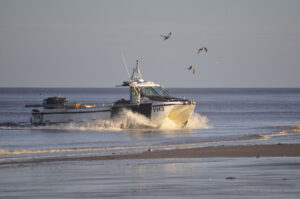
John Davies’ (just) U10 Cheetah cat is a bit bigger than most beach-launched boats in the Cromer crab fleet…
John Davies, on Richard William YH 3, works with two crew – one of the few fishermen to do so.
“They’ve said potting is fine all the way along. And now they think they might have to stop all fishing on the rugged chalk. Without this chalk, we don’t have a fishery. It’s why we are here. They are mostly small boats – 6m and 7m, open boats, single-handed, and not capable of working any further.
“I’ve had several sleepless nights and I know others have, especially those with kids and mortgages – what are they going to do?
“There is a great opening for youngsters here, because in 10 years’ time, most here now will have retired. On the IFCA, we’ve been thinking about how we can get youngsters involved, with apprenticeships and that sort of thing. Well, this report stops that for now.
“I know one young lad who’s skippering a boat away at the moment, but was thinking of coming home and buying a small catamaran, and making a living here on his doorstep. But he’s not going to invest any money at the minute. My family has done it for eight generations or more. I’m quite glad my son didn’t go into it, as things are looking now.”
John Lee
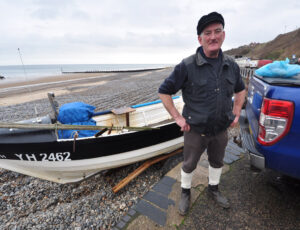
John Lee: “My boat supports 14 jobs.”
John Lee, from a long family line of Cromer fishermen, works a Tactile skiff, Leah YH 2462.
“The Natural England report is lengthy, but thin on content – very little evidence, and they not are comparing it with anything else. They are not saying that 40 years ago the reef looked like such and such, and now it looks like this. They are going on what it looks like now, and so there’s no comparison.
“There has been potting to a pretty similar system for well over 100 years, probably 120. And we’re still getting crabs and lobsters out. We’re getting more lobsters than we ever have. If we were harming it in any way, the fishing wouldn’t be as sustainable as it is.
“With everything else at the moment, you don’t need the mental stress. It’s hard enough to make a living out of the job now, without the added pressures of things like that. We’re just not doing the harm they’re suggesting.
“My crab shop supports three other jobs, and we also own a seafood restaurant where, if we don’t have crab and lobster, people will turn around and walk out. That restaurant supports 10 jobs. So my boat that I work single-handed supports 14 jobs.”
Andrew Webster
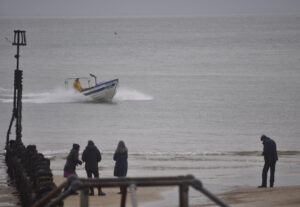
A boat coming in usually attracts a few onlookers.
Andrew Webster, on Irene D II YH 212, is a slight exception to the rule on two counts: firstly, he doesn’t come from a fishing family, although his wife Nicola does, and secondly, he’s under 40, and there aren’t many of his vintage on the coast now.
“I’ve been going to sea for the 21 years since I left school. When it’s clear, you can see all the weed and the gullies, and it looks no different now to what it did 20 years ago. And there’s less fishing now. You’ve got 14 boats on this beach, and I reckon probably half the fishermen are in their sixties, if not seventies.
“When we were told by EIFCA that potting on the rugged chalk might have to be banned, we felt devastated. So did most fishermen along this coast. How can four dives be enough to decide that? To cause stress and worry like this is unacceptable.
“We were also shocked when one of the report’s authors came down about the time the report was published, and she was unaware that we don’t actually store pots on the rugged chalk. Out there doesn’t make a very good shed, does it? And we know when it is appropriate to fish the rugged chalk – in fine weather only.
“Who would damage their place of work? Our North Norfolk Fishermen’s Society was instrumental in the 1960s in implementing a no-trawling byelaw that is still in place today, to protect the very seabed we work.”
David and Simon Bywater

Simon and David Bywater.
Brothers David and Simon Bywater fish from East Runton, and so does another brother, Peter, along with David’s son Matthew. Their four boats more or less fill the bottom of the cleft that gives access to the beach – sort of Bywater Beach, you might say. And David has a crab and lobster processing factory up in the village.
“My brothers sell to me,” says David. “Simon and Peter, and Matthew my son, all fishing from here at East Runton. And so do cousins, and other fishermen along the coast. Then we employ five people on the processing, and we’ve got two refrigerated vans with drivers. And we make all our own gear.”
“NE is advising an adaptive approach,” says Simon. “And otherwise the precautionary approach – basically banning it. But they are saying this based on four dives and virtually no evidence.
“My stepson, Jack, 17, is at college two days a week, and he goes to sea with me. He’s done all his training, and he’s half thinking of going to sea – he loves it – but now he’s not so sure. Something like this could tip the balance the wrong way.”
Fuzz Middleton
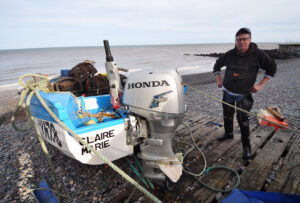
Fuzz Middleton, a fourth-generation fisherman.
Fuzz Middleton on Claire Marie YH 78 is from a Sheringham fishing family going back at least to the late 19th century.
“The MCZ was brought in, but now Natural England has suddenly said: ‘Oh, we’ve got to save the reef.’ And they make out that we’re the bad guys. But it was us who had a byelaw brought in to protect the ground from Blakeney church to Happisburgh light from trawlers. They don’t treat us as conservationists, but we are.
“We don’t want to flatten that seabed, because that would be detrimental to us. We want to go where there’s plenty of contour, because that’s where the organisms are – the shrimps, the food chain. We want that ourselves. Added to which, I’m probably using 40kg to 60kg of bait per day, and what the crabs and lobsters don’t eat goes into the wider food chain – the shrimps and smaller organisms.
“And storing pots at sea? Nobody does that. I’ve sometimes kept pots fishing at sea all year, but not this year – I’m bringing them in now. Some people leave a few pots out through the winter, turning them over every few days, but certainly not on the chalk, because they’d get knocked to pieces. When you’re talking about pots worth £100 each, you’re talking about a lot of money. And when heavy weather’s forecast at any time of year, we move them out anyway. When you get a storm here, the bottom has an awful lot of broken chalk.”
Kevin Jonas

Kevin Jonas.
Fisherman Kevin Jonas set up Jonas Seafoods in 1995, and the company was incorporated in 2004. It buys crabs and lobsters from most fishermen along the coast and supplies whole crab, dressed crab, crabmeat and lobster to the UK retail sector. It has become one of the biggest – perhaps the biggest – employer in Cromer, with 72 currently on the payroll.
“If fishing the chalk reef was banned, it would have a big effect on us. We rely on crabs off that reef from the guys fishing from the beach – more particularly in the early part of the season when the visitors are arriving. And the bulk of our lobster comes from there, too.
“I was involved in the Net Gain project which was the initial set-up for the MCZ and, naively at the time, I listened to them talking about the MCZ being a good thing for the fishery, because Natural England said it had no problem with potting at all.
“But now there is this new advice, and we were quite surprised to see that it is based on just four dives. And with it comes the potential damage to businesses like ourselves, and the jobs involved. We’re labour-intensive – that’s just the nature of the beast. But then there is the effect on the much bigger business, which is tourism.”

